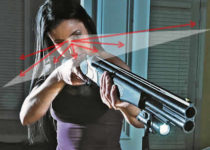Glocks – Grip Angle – Handguns for Self Defense

If you didn’t know, Glocks are a polarizing brand in firearms. In fact, Keltec Sub 2000s take Glock magazines. They’re reliable, accurate, and my experience carrying and shooting the same Glock for over 14 years is that it will shoot anything that you put in them.
John Browning designed the 1911 with an angle between the barrel and the grip that happens to be the angle that most people’s fist is at when they throw a punch.

The Glock, on the other hand, has a grip angle that’s just a few degrees more. This happens to be approximately the angle that martial artists punch with if they’ve learned to concentrate the impact of their strikes on the knuckle of their index finger and middle finger rather than across all 4 fingers. (vertical punch)
Here’s where this comes into play. After reviewing thousands of lethal force encounters with handguns, it becomes obvious that under extreme stress and high pulse rates, people instinctively punch their firearm out one handed and pull the trigger. As they’re punching under stress, very few people end up firing with their handgun straight up and down and most have it canted to the side somewhere between 10 and 11 o’clock from the shooter’s perspective as if they were throwing a punch.
Keep in mind that this isn’t an issue when shooting competitions or qualifiers. It is specifically an issue when stress levels are so high and pulse rates are so high that gross muscle movements and reptile brain thinking take over and your body responds with a lot more instinct than thought.
The result of this is that if you’re shooting a Glock and you do a high volume of consistent training or you’ve done extensive training to focus the impact of your punches on the knuckle of your index finger and middle finger, you’ll probably hit close to what you’re aiming at.
Both of these are the case for me. I train extensively with my Glocks AND I’ve thrown focused punches for the last two decades. I’m not sure what WAS natural for me before all of this, but by now, my arms, hands, and muscles are hard-wired to throw out my fist in a two knuckle punch…and line up the sights perfectly on my Glocks.
But if you’re used to punching traditionally with all 4 knuckles (as most people are), there’s a good chance that your shots with a Glock will go high and to the left when you’re under stress. Incidentally, this matches up with analysis of over a decade of after action reports of officer involved shootings. In one semi-famous case, officers fired more than 30 rounds at a bad guy firing back at them IMMEDIATELY ON THE OTHER SIDE OF A BED! Nobody was seriously injured in this demonstration of instinctive shooting.
So, how do you take this fascinating bit of trivia and turn it into something other than simple fodder for debate with your gun buddies?
The answer depends to a certain extent on which of the following two groups you find yourself in…
1. Those who have Glocks.
2. Those who don’t.
If you have a Glock, go through the following drill. You can do it either while practicing dry fire after following all necessary steps to make sure that you do NOT have a loaded weapon or you can do it with a loaded weapon at a range.
1. With your firearm at your side or holstered, pick a target that is 5-10 feet away.
2. Close your eyes.
3. “Punch” your firearm at where you think the center of the target is. Use the same stance that you’d use if you were punching a heavy bag. This probably means that your feet are slightly more than shoulder width apart, your dominant leg is back slightly, your weight is equally distributed between your legs, knees bent slightly, shoulders rolled forward and closer to your target than your hips are.
4. Open your eyes and see where you are, in fact, aiming. Try to keep your firearm exactly where it is and move your eyes as necessary to line up with the sights to see where you’re aiming.
5. Either mark where you were aiming with a pen, shoot (if safe), or make a mental note and repeat 5-10 times.
Wherever the majority of your rounds land will roughly be your natural point of aim and will probably be what your groupings would look like in a high-stress lethal force encounter unless you regularly do firearms training under stress.
If the group is tight, but high and to the left, then you’re going to want to either do a significant amount of dry fire / airsoft training / range time to change your natural grip angle to match the Glock or find a handgun that matches your grip angle.
If you don’t really have a group and the shots are random then you are going to want to do a significant amount of dry fire / airsoft training / range time to establish a consistent natural point of aim.
The next time that you go shopping for a pistol, whether it’s a Glock or not, I suggest that you go through the 5 step process above with as many firearms as you can and pick the firearm that best matches your instinctive grip angle.
Regardless of whether you have a handgun that matches your current natural grip angle, the more you train with your firearm and the more stressful your training, the more likely you’ll be to hit what you need to if you find yourself under high stress in a lethal force encounter.
This drill can be particularly useful when working with new shooters, as it helps you stack the deck in their favor for having positive experiences early on with shooting.
Source:David Morris – DailyCaller
Revised by Jon Hines



